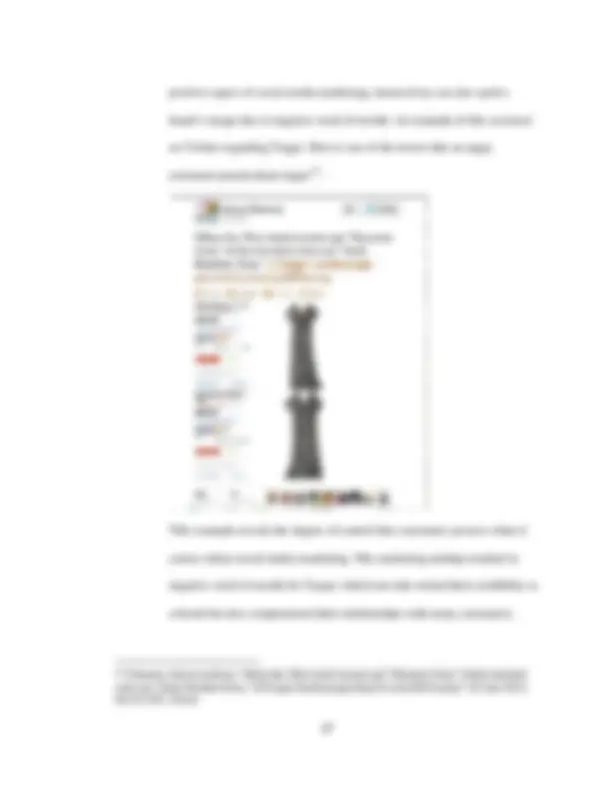





















































































Study with the several resources on Docsity

Earn points by helping other students or get them with a premium plan


Prepare for your exams
Study with the several resources on Docsity

Earn points to download
Earn points by helping other students or get them with a premium plan
Community
Ask the community for help and clear up your study doubts
Discover the best universities in your country according to Docsity users
Free resources
Download our free guides on studying techniques, anxiety management strategies, and thesis advice from Docsity tutors
The information gleaned from analyzing social media efforts of Nike and. Adidas can then be extrapolated and used to improve the social media efforts of other.
Typology: Lecture notes
1 / 91

This page cannot be seen from the preview
Don't miss anything!




















































































Presented to the Department of Marketing and the Robert D. Clark Honors College in partial fulfillment of the requirements for the degree of Bachelor of Science in Business Administration June 2014
An Abstract of the Thesis of
Me ghana Deodhar for the degree of Bachelor of Science in the Department of Marketing to be taken June 2014 Title: To Like or Not to Like: When Social Media Marketing is Effective
Kathryn Mercurio Social networking sites (SNS's) are a set of internet-based applications that allow individuals to create content, connect with friends, and communicate with one another. As these SNS's have evolved, marketers have realized the tremendous untapped potential that these sites possess as a marketing tool due to their interactivity, accessibility and efficiency. As the popularity of social media has increased, it has given consumers a great deal of power to influence others in their social network regarding a brand or company. Due to this shift, it is essential for companies to understand when it is critical to use this medium and how to use it effectively. The purpose of this thesis is to investigate when social media marketing is effective for athletic apparel companies targeting female consumers. Social media not only serves to strengthen the relationships that companies have with their core customers but, it also influence profits, if used effectively.
li
Introduction With the stroke of a fingertip, humans now have the ability to interact with people across the world. Social media has become infused in every act and action in society—it has penetrated almost every society and has arranged people into an interconnected human community. Marshall McLuhan, a philosopher of communication theory describes this community as a global village, which states that humans can no longer live in isolation, but rather will always be connected by continuous and instantaneous electronic media 1. This is further exemplified by the presence of social media and social networking sites. The original popularity of social networking sites was due to individuals seeking to interact with family, friends and those in their communities—social networking was heavily focused on personal interactions. However, in recent years, companies have begun to use social media platforms to market products and services due to the advantages they offer regarding interactivity, accessibility and efficiency. This phenomenon of marketing on social media has shifted the power from companies to consumers. Consumers now have the ability to discuss a brand with or without company involvement. As the popularity of social media increases, it gives consumers a great deal of power to influence others in their social network regarding a brand or company. As this trend develops further, and the power dynamic shifts from the companies to the
(^1) West, Richard L., and Lynn H. Turner. Introducing Communication Theory: Analysis and Application. Boston: McGraw-Hill, 2010. Print.
matured to what they are today. In order to understand if and when social media is worth investing in, one must assess the benefits and the pitfalls of using this tool through the perspective of a marketer. Although one may determine the effectiveness of social media with ROI metrics, this paper will judge social media effectiveness through public relations’ relationship management theory. I examine social media through this perspective because public relations and social networking for companies are parallel in purpose and value. After the academic review of measurement principles, I will investigate the social media strategies of Nike and Adidas, specifically their women’s divisions, to identify elements of posts that are received positively by the target consumers. The information gleaned from analyzing social media efforts of Nike and Adidas can then be extrapolated and used to improve the social media efforts of other companies with similar target markets and goals. One company that could benefit from this research could be Nordstrom—another high-end retailer that targets younger, upper class women that value quality.
Definitions Social media has become an umbrella term for many different technologies, platforms, online conversations and communities. For the purposes of this thesis, social media will be defined as a medium for people to use online technologies to share their opinions, obtain information, support, ideas, and products from each other^3. From this
(^3) Li, Charlene, and Josh Bernoff. Groundswell: Winning in a World Transformed by Social Technologies. Boston, MA: Harvard Business, 2008. Print.
definition it is clear that collaboration is core tenet of social media. Five main characteristics of social media that reinforce collaboration are as follows^4 :
Although this definition of social media is evolving and likely to change in the future, currently, there are six kinds of social media^5. The definitions of these terms are important for the understanding of this thesis. The six basic forms are as follows:
(^4) Mayfield, Antony. What Is Social Media? Vol. 1.4. N.p.: ICrossing, n.d. ICrossing. 8 Jan.
History Evolution of the Web The main goal of Web 1.0 was to allow people to upload information onto a portal so it could be accessed anywhere. Web 1.0 had static information, was updated infrequently and served as a tool to push information to users^6. The content generators of this version of the web were mostly companies who could dictate conversation topics, news and trends and could push this onto users. The downfall of web 1.0 was largely due to the fact that it was very slow to operate and content was limited in variety. The web 1.0 was followed by web 2.0 which moved further away from pushing
(^6) Evans, Mike. The Evolution of the Web-From Web 1.0 to Web 4.0. Plymouth: Cscan.org, 11 Aug. 2006. PPT.
content and migrated towards users pulling content which therefore increased interactivity—a powerful tool in social media today. The electronic boom was exemplified by the introduction of the Web 2.0, which developed in the wake of the dot.com crash in 2001^7. Web 2.0 represents an updated version of the original World Wide Web, which was essentially a new “set of tools that allow people to build social and business connections, share information and collaborate”^8. As the web transitioned from a read-only environment to an interactive community, the demand for the Internet has increased more than ever before. With this growing dependency on electronic media, Internet users have started demanding rapid, accurate, and interactive information, which has brought about the ubiquitous phase of social media. The success of web 2.0 can be largely attributed to the increase in content variety and high levels of interactivity—predominant factors in the success of social media.
History of Social Networking Sites The first generally recognized social networking site, SixDegrees.com launched in 1997. SixDegrees allowed consumers to create profiles, list friends and surf other users’ friend lists. Although some these features existed in some form prior to SixDegrees, they were the first to combine these features to create the first social networking site. They promoted themselves as a tool to help people connect with and send messages to each other. Although SixDegrees attracted millions of users, the (^78) "What Is Web 2.0." New Titles. N.p., n.d. Web. 04 Nov. 2013.
Web 2.0 World."Parise, Salvatore, Patricia J. Guinan, and Bruce D. Weinberg. "The Secrets of Marketing in a Wall Street Journal. Wall Street Journal, 15 Dec. 2008. Web. 4 Nov. 2013. http://online.wsj.com/news/articles/SB122884677205091919.
advantage of Friendster’s alienation of its early adopters. MySpace differentiated itself by regularly adding features based on user demand and by allowing users to personalize their pages^10. MySpace gained much of its popularity as teenagers started joining MySpace en masse in 2004. Unlike Friendster, MySpace accommodated their policies and started allowing minors however their eagerness to accommodate their policies also decreased their popularity. “The site was implicated in a series of sexual interactions between adults and minors” which created a moral panic^11. It was the introduction of Facebook however, that truly revolutionized the industry. Unlike previous SNS’s, Facebook was created to support only distinct college networks. The first of these networks was the community at Harvard University, which only allowed students with valid university issued e-mails to participate. Slowly, Facebook began supporting other schools, and then high school and now supports billions of people worldwide^12. Unlike previous SNS’s that prevented public profile viewing, Facebook allows users to choose their privacy restrictions. Another differentiating feature of Facebook is the ability for developers to create applications that are supported by Facebook. These apps allowed users to personalize their profiles and interact within niche communities. Soon after the rise of Facebook came the introduction of Twitter—the leading SNS in micro-blogging. Twitter is a platform that allows users to create succinct status updates that are a maximum of 140 characters. Micro-blogging “tools provide a light-
(^1011) Danah M Boyd and Nicole B. Ellison. 12 Danah M Boyd and Nicole B. Ellison.Qualman, Erik. "Social Media Video 2013." YouTube. YouTube, 07 Nov. 2012. Web. 08 May 2014.
weight, easy form of communication that enables users to broadcast and share information about their activities, opinions and status.”^13 In comparison to traditional blogging, micro-blogging fulfills the need for even faster communication—it lowers users’ requirement of time and thought investment for content creation. The other differentiating aspect of twitter micro-blogging is the frequency of status updates. In traditional blogging, users may post once a day or every few days whereas micro- blogging encourages people to “tweet” several times throughout a day. This rapid delivery of bite-sized information makes twitter a source of breaking news and information for many users. An example of this was when New Yorkers received tweets about an east coast earthquake 30 seconds before they felt it^14. Since the conception of the SNS’s, it is evident that social networks have undergone huge transformations. However the main tenant remains the same—social networking sites still allow users to connect, network and interact with people in their extended communities through the ease of the Internet and SNS platforms. As social networking sites began advancing, they have also become heavily commercialized as companies and brands have realized the tremendous benefits these platforms offer. The introduction of marketing into these platforms is not too surprising considering the fact that almost half of 18-34 year old users check their Facebook account as soon as they wake up, and 28% report doing so on their mobile devices before even getting out of
(^13) Halper, Jordan. "Social Media As A News Source (with Images, Tweets) · Jordanhalper." (^14) Qualman, Erik. Storify. N.p., n.d. Web. 08 May 2014.
Benefits of Social Media Marketing Advertising budgets that previously went to traditional advertising, such as, television, print ads, and outdoor boards have now been moved to the digital sphere of advertising for the benefits that this medium offers. The primary benefits that social media offers for companies are as follows:
1. Personification: Corporations and brands can be your Friends The interactivity that social media offers allows consumers to rely on various types of social networking sites to pull information about products and the brand rather than a traditional web 1.0 website that simply pushed information onto consumers. This ability to directly communicate with brands makes interaction more personable and friendly^17. According to research conducted by Jennifer Aaker, brands have the ability to create human-like characteristics that people can then associate themselves with^18. This personification of brands is made easier when brands have a social media presence—corporations can directly interact with people, like friends can interact with friends, they can share opinions and ideas like a traditional human-to-human interaction on a social networking platform.
(^17) Nigam, Ashutosh. "Influence of Social Networking Sites I Influence of Social Networking Sites I Nce of Social Networking Sites in Brand N Brand Development Practices DevelopmentPractices from Marketer’s Prospective Marketer’s Prospectiv." International Journal of Computer Science & Management Studies (^18) Aaker, Jennifer L. "Dimensions of Brand Personality." 12.02 (2012): 46-52. Web. 08 Mar. 2014. Jmr, Journal of Marketing Research. 34.3 (1997): 347. Print.
2. Accessibility One of the primary benefits that social media marketing offers to marketers is audience accessibility. Through these networks, marketers are given nearly boundless access to consumers via the Internet and particularly through SNS’s. For the advertising industry, the new WWW is a promising medium in which to access and engage consumers. The popularity of the web as a commercial outlet is largely due to its ability to facilitate global sharing of information and resources and its potential to provide an efficient channel for advertising, marketing and even the distribution of goods and information services^19. As of the third financial quarter of 2013, Facebook reported 1.19 billion monthly active users^20 , along with Twitter who reported 231.7 million monthly active users worldwide^21. These values when combined exceed the current population of India, which represents approximately about 17% of the world^22. With such a large population of active SNS users, it is no wonder that marketers have demonstrated their increasing presence on these sites. These sites not only present opportunities for marketers to access large masses of people but they also provide information to consumers 24 hours a day. This 24-hour access becomes a win-win for both the marketers and the consumers since marketers
(^19) Hoffman, Donna L., Thomas P. Novak, and Patrali Chatterjee. "Commercial scenarios for the Web: opportunities and challenges."0-0. Journal of Computer ‐ Mediated Communication 1.3 (1995): (^20) "Investor Relations." Facebook Reports Third Quarter 2013 Results. Facebook, 30 Oct. 2013. Web. 04 Nov. 2013. http://investor.fb.com/releasedetail.cfm?ReleaseID=802760. (^21) Ahmad, Irfan. "30 of the Most Amazing Twitter Statistics [INFOGRAPHIC]." RSS. Social Media Today, 24 Oct. 2013. Web. 04 Nov. 2013. http://socialmediatoday.com/irfan-ahmad/1854311/twitter-statistics-IPO-infographic. (^22) "India." Data. World Bank, n.d. Web. 04 Nov. 2013.
to construct and refine information by way of written communication^25. SNS’s provide users a way to communication through writing, whether is be posting online, instant messaging, texting or tweeting. Written communication provides the opportunity to polish communication, and self-enhancement concerns lead people to use that opportunity to talk about more interesting products and brands.^26 This shows that asynchrony encourages people to engage in selective self-presentation—calculated posting makes the consumer feel better and smarter—which increases the engagement and interactivity of social media sites. The nature of social media as an interactive tool, allows for asynchronous conversation, and therefore assists the relationship that consumers can have with various brands and companies. Firms will reap the benefits of innovation in interactivity by being closer to the customer than ever before^27.
4. Efficiency a. Cost-Effectiveness Another reason that social media marketing has become prevalent is because it is cost effective. In a world that is transitioning away from traditional marketing, which is often very expensive, social media marketing is helpful because there is far less risk if a campaign or advertisement does poorly. For example, “the average sponsorship cost for a NASCAR car is in the $15 million to $20 million range. In comparison, the social media campaign costs between $200,000 and (^25) Berger, Jonah, and Raghuram Iyengar. "Communication Channels and Word of Mouth: How the Medium Shapes the Message." (^26) Berger, Jonah, and Raghuram Iyengar (^27) Hoffman, Donna L., Thomas P. Novak, and Patrali Chatterjee
$300,000.”^28 The financial risk associated with social media marketing is far less—therefore making it a more appealing option for marketers. b. Trackable & Measureable Another aspect of efficiency that social media marketing provides is that is it is more trackable and measureable than traditional marketing. There are numerous measures that marketers can utilize to determine the effectiveness of their online advertising efforts, such as, number of new visitors, number of visits, page views, ad views, and clicks through rate. On the other hand, the most common measurement tool for traditional advertising is to use custom landing pages, coupon/ad codes and custom phone numbers. The concern with this measurement technique is that it is not a measurement of viewers to conversions, which is vital for tracking effectiveness.
Drawbacks of Social Media Marketing Despite the unprecedented benefits that social media marketing offers to the advertising industry it is also important to consider the drawbacks marketers face using social media marketing. Some of the drawbacks are as follows:
1. Control in the Hands of the Consumer One of the risks associated with using social media marketing is the tremendous control that users possess. Although interactivity is considered a
(^28) Qualman, Erik.